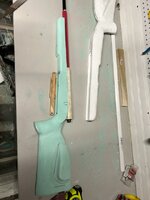RepeatPete
FNG
- Joined
- Aug 13, 2023
- Messages
- 66
I’ve decided to jump into the deep end and make my own carbon fiber stock. This will be going on a M700 7mm Rem mag, which currently wears a wood stock.
I did a ton of research here, read a lot of @Formidilosus posts, and decided I wanted a vertical grip, negative comb stock. I’m taller, so I’ve always added spacers to get a proper LOP and have recently added spacers under a stock pack to be a proper check weld. A custom stock would solve both of these, and cut some weight from a pretty heavy gun as well. My main influences were the first gen Gunwerks Magnus and the Peak44 Bastion.
My wish list was a 14 3/8” LOP (1” longer than stock M700), negative comb, trim forend for weight and carrying (I rarely shoot off bags or front rests other than tree branches), relatively straight toe line, and flush mounted Arca rail close to the central balance point.
I started out with an $8 takeoff stock from eBay for a good pattern, and laminated polystyrene insulation board for my mold. I cut and carved it most of the way before realizing it was too soft for my vacuum bagging process. So I repeated the process with green insulation board from Lowe’s, which is stiffer and finishes much nicer.
I also bought a bare long action bedding block from Stocky’s, the Arca balance rail from SRS, and a Microcell recoil pad. The skin will be carbon fiber, the aluminum bedding block will be bonded in place with Marine Tex with two carbon fiber rods as cross bolts through the bedding block.
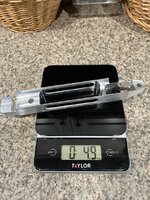

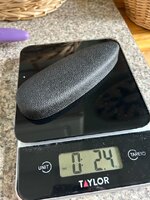
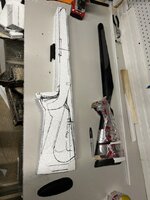

I am going to use a low budget vacuum bagging setup (vacuum storage bag from Harbor freight) with peel ply and a breather layer. The shell will be from a carbon fiber sleeve, like the “sock” in the infamous Sako video.
I was going to wait until I had a successful layup before posting, but I want to ask: any input on stock design or build process?

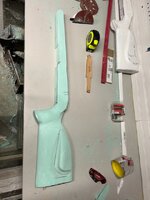
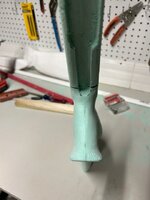
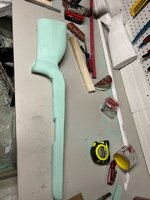
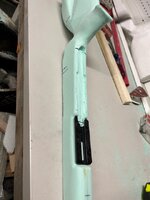
I did a ton of research here, read a lot of @Formidilosus posts, and decided I wanted a vertical grip, negative comb stock. I’m taller, so I’ve always added spacers to get a proper LOP and have recently added spacers under a stock pack to be a proper check weld. A custom stock would solve both of these, and cut some weight from a pretty heavy gun as well. My main influences were the first gen Gunwerks Magnus and the Peak44 Bastion.
My wish list was a 14 3/8” LOP (1” longer than stock M700), negative comb, trim forend for weight and carrying (I rarely shoot off bags or front rests other than tree branches), relatively straight toe line, and flush mounted Arca rail close to the central balance point.
I started out with an $8 takeoff stock from eBay for a good pattern, and laminated polystyrene insulation board for my mold. I cut and carved it most of the way before realizing it was too soft for my vacuum bagging process. So I repeated the process with green insulation board from Lowe’s, which is stiffer and finishes much nicer.
I also bought a bare long action bedding block from Stocky’s, the Arca balance rail from SRS, and a Microcell recoil pad. The skin will be carbon fiber, the aluminum bedding block will be bonded in place with Marine Tex with two carbon fiber rods as cross bolts through the bedding block.





I am going to use a low budget vacuum bagging setup (vacuum storage bag from Harbor freight) with peel ply and a breather layer. The shell will be from a carbon fiber sleeve, like the “sock” in the infamous Sako video.
I was going to wait until I had a successful layup before posting, but I want to ask: any input on stock design or build process?






